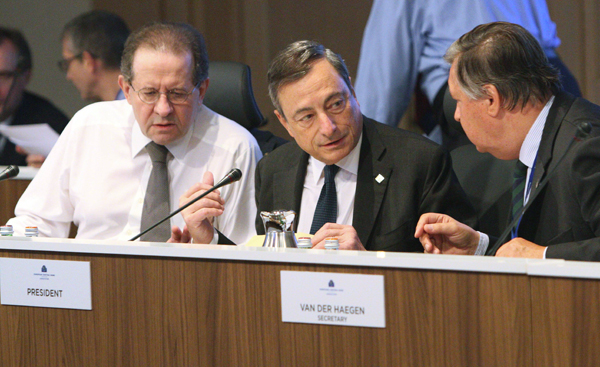VALLETTA/FRANKFURT — The European Central Bank (ECB) is studying new stimulus measures that could be unveiled as soon as December and is prepared to cut its deposit rate deeper into negative territory if needed to fight falling prices, its president said on Thursday.
Consumer prices in the 19-country eurozone slipped by 0.1 per cent in September, prompting calls for the ECB to expand or extend its 60 billion euros ($68 billion) a month of asset purchases. The programme was launched in March to help push inflation back to the ECB’s target of just under 2 per cent.
ECB chief Mario Draghi indicated that falling inflation expectations, driven in part by lower-than-expected demand for oil, have led the central bank to consider a wide variety of possible measures, including a deposit rate cut, to shore up inflation.
“We are ready to act if needed... and we are open to the full menu of monetary policy,” Draghi said. “The Governing Council has tasked the relevant committee to examine the pros and cons of various measures... The attitude is not wait and see but work and assess.”
Draghi added that the ECB’s governing council, which includes the executive board and the heads of the bloc’s 19 central banks, would be in a better position to make a decision once it gets new inflation forecasts from its staff in December.
He highlighted a stronger euro, falling commodity prices and a worsening of the economic conditions in emerging markets as the key risks that the ECB will monitor. A fading of the base effect from 2014’s oil price plunge may also have helped push inflation higher by then.
“In this context, the degree of monetary policy accommodation will need to be re-examined at our December monetary policy meeting,” he said.
Deposit rate cut
After stating a year ago that no further cuts to the deposit rate, already in negative territory, were on the cards, Draghi noted that was one of the instruments the governing council had discussed and may use.
“When expectations of inflation become more and more negative, we have higher and higher real rates,” Draghi said. “That’s one of the reasons why we considered other non-standard policy measures, one of which was the negative rate of the deposit facility.”
The ECB first pushed its deposit rate below zero in June 2014, effectively making banks pay to park funds overnight at the central bank. Two months later, it was trimmed to -0.20 per cent, and Draghi said no additional rate cut was possible.
He dismissed suggestions that this turnaround might dent the ECB’s credibility in financial markets.
“The credibility of a central bank is measured by its ability to comply with its mandate and to this extent any instrument could be potentially used,” Draghi explained “Given the conditions prevailing a year ago, that was the statement. Today things have changed.”
QE
Before Thursday, financial analysts’ core view was that the ECB would intervene in December or January to extend or expand its quantitative easing (QE) scheme, while few expected a deposit rate cut.
Draghi’s words strengthened those expectations but gave little away as to which tool the ECB was likely to choose.
“It was an open discussion on all the monetary policies,” Draghi said. “We have discussed some other monetary policy instruments besides [a deposit rate cut].”
Analysts have warned that upping the pace of purchases may create a shortage of bonds down the line and that extending the scheme may require the ECB to change some of the rules of engagement to avoid hitting technical limits.
These issues, along with the ECB’s failure to revive the market for asset-backed securities, have raised the prospect of an expansion in the range of assets that the ECB can buy to include corporate bonds or even equities.
But its direct involvement in private corporations could meet political and internal resistance.
In a direct call to eurozone governments to add their weight to a still-tentative recovery in the region, Draghi stressed that structural reforms and fiscal measures to stimulate demand were also needed.
“Monetary policy shouldn’t be the only game in town,” Draghi emphasised. “We have to address also the structural component of this recovery so we can move from a cyclical to a structural recovery.”
